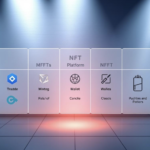Now Reading: Top Cryptocurrency to Invest in Today: Best Options
- 01
Top Cryptocurrency to Invest in Today: Best Options
Top Cryptocurrency to Invest in Today: Best Options

What began as an experimental digital currency in 2009 has exploded into a global financial phenomenon. The blockchain ecosystem now boasts over 10,000 unique projects, collectively valued at more than $1 trillion. This rapid expansion reflects growing institutional interest and technological innovation reshaping modern finance.
Daily trading volumes regularly exceed $50 billion, signaling mainstream acceptance. Major corporations now integrate blockchain solutions for payments, contracts, and supply chains. Financial institutions increasingly view digital assets as essential components of diversified portfolios.
However, not all projects deliver lasting value. While creativity drives the space forward, only assets with clear utility and robust networks tend to survive market cycles. Strategic selection separates fleeting trends from transformative technologies.
Key Takeaways
- Blockchain technology supports over 10,000 active projects worldwide
- Total market valuation surpasses $1 trillion with daily trades in billions
- Businesses adopting fintech innovations gain competitive advantages
- Real-world applications determine long-term project viability
- Volatility remains high despite growing institutional participation
Understanding Cryptocurrency Fundamentals
Digital assets operate on principles that challenge traditional finance. At their core, these systems rely on advanced math and shared networks to verify value transfers without middlemen. This innovation creates new opportunities for secure global exchanges.
What Is Cryptocurrency?
A digital currency uses cryptography to protect transactions and manage new unit creation. Unlike physical money, it exists only in digital form across a distributed network. Every action gets recorded permanently on a shared ledger visible to all participants.
How Blockchain Technology Works
Blockchains act as unchangeable record-keeping systems. Each “block” contains batches of verified transactions linked in chronological order. Network participants called nodes maintain copies of the entire chain, preventing single-point failures.
| Feature | Blockchain Systems | Traditional Systems |
|---|---|---|
| Ledger Type | Decentralized & Public | Centralized & Private |
| Security Method | Cryptographic Proof | Institutional Trust |
| Update Authority | Network Consensus | Central Administrators |
The open-source nature of blockchain technology allows continuous innovation. Developers worldwide build tools that expand functionality, from automated contracts to decentralized apps. This collaborative approach drives rapid evolution in the crypto space.
Three key advantages define these systems:
- Transparency: All participants verify transaction histories
- Security: Cryptographic protection prevents tampering
- Accessibility: Global networks operate 24/7 without gatekeepers
Why Consider the Top Cryptocurrency to Invest in Today?
Modern financial systems are witnessing a paradigm shift as digital assets evolve beyond speculative tools. Over 46 million Americans now use crypto for daily transactions, reflecting its growing role in commerce. Peer-to-peer networks enable direct value transfers between users, cutting out banks and reducing fees by up to 80% compared to traditional methods.

Businesses benefit from instant settlements and borderless payments. A coffee shop in Miami can now receive payments from Tokyo in seconds without currency conversion hassles. This efficiency explains why 34% of U.S. retailers plan to accept crypto within two years.
For investors, opportunities extend far beyond buying low and selling high. Decentralized finance platforms let users:
- Earn interest through staking (average 5-12% APY)
- Trade assets 24/7 on global markets
- Govern blockchain projects via DAO participation
| Feature | Traditional Finance | Crypto Solutions |
|---|---|---|
| Transaction Speed | 3-5 business days | Instant |
| Fees | $15-$50 wire transfers | $0.01-$2 network costs |
| Control | Third-party managed | User-owned wallets |
| Accessibility | Banking hours | 24/7 global network |
The market maturity creates dual value streams. Assets function as spendable currency and appreciating investments. Savvy holders diversify portfolios by exploring high-potential altcoins alongside established options.
Price stability mechanisms in newer projects reduce volatility risks. Automated smart contracts enable secure lending, borrowing, and yield farming – turning idle assets into income generators. This ecosystem growth positions crypto as both practical payment tools and wealth-building instruments.
Product Roundup: Leading Crypto Options
Digital money continues evolving, with select projects demonstrating lasting power. This analysis examines five major players shaping the crypto space through unique technological approaches and real-world applications.

Key Features of Top Digital Assets
Bitcoin remains the market’s foundation stone with a $2.25 trillion valuation. Created in 2009, its proof-of-work system maintains unmatched security for value storage. Many consider it digital gold due to finite supply and widespread adoption.
The Ethereum platform revolutionized finance through smart contracts. Its $538 billion market cap reflects dominance in decentralized apps and NFTs. Recent upgrades improved transaction speeds while reducing energy use by 99%.
- BNB: Powers the world’s largest exchange ecosystem ($119B cap)
- Solana: Processes 65,000 transactions/second ($113B cap)
- XRP: Enables instant cross-border payments ($171B cap)
These assets represent different blockchain philosophies. Exchange tokens like BNB offer trading fee discounts. Speed-focused networks like Solana target developers building scalable apps. Payment specialists like XRP work with financial institutions.
Market leaders share three critical traits:
- Established user bases exceeding 10 million
- Continuous technological improvements
- Clear regulatory compliance strategies
While newer tokens emerge weekly, these five maintain dominance through practical utility. Their market positions suggest staying power as the industry matures.
Assessing Market Trends and Growth Potential
Blockchain assets demonstrate varied trajectories shaped by adoption and utility. Tracking key metrics helps identify projects with staying power amid rapid industry changes.
Market Cap Analysis and Performance Metrics
Market capitalization remains the gold standard for evaluating crypto stability. Bitcoin and Ethereum dominate with combined caps exceeding $2.8 trillion. This represents 72% of the entire sector’s value.
| Asset | Initial Price | Current Price | Growth % |
|---|---|---|---|
| Bitcoin | $0.06 | $113,056 | 182,840,056 |
| Ethereum | $2.83 | $4,460 | 157,431 |
| BNB | $0.12 | $854 | 741,956 |
Projects above $5 billion in market cap show lower volatility. They attract institutional buyers seeking liquidity. Smaller assets often lack this stability despite higher short-term gains.
Three factors drive sustained growth:
- Network upgrades improving transaction speeds
- Regulatory clarity boosting investor confidence
- Real-world payment integrations
Price movements correlate with technological milestones. Ethereum’s 2023 upgrade reduced energy use by 99%, sparking a 62% value increase. Monitoring these developments helps spot emerging opportunities.
The Role of Smart Contracts and Decentralized Apps (DApps)
Digital agreements are rewriting business rules across industries. Smart contracts automate processes using code instead of paperwork, cutting delays and human errors. These tools power everything from insurance claims to royalty payments without needing lawyers or banks.

How Automated Agreements Work
Ethereum’s blockchain pioneered self-executing contracts that trigger actions when conditions meet. Imagine a vending machine: insert crypto, receive a product. Now apply this logic to loans, trades, or content licensing. The code enforces rules impartially.
Three sectors transformed by this technology:
- Finance: Loans approve in minutes, not weeks
- Gaming: Players own in-game items permanently
- Art: NFTs guarantee creator royalties on resales
Over 3,000 decentralized applications now operate on Ethereum. Developers build tools for voting systems, supply chains, and prediction markets. This ecosystem grows as more industries recognize efficiency gains.
Platforms supporting smart contracts often see higher user retention. Active developer communities signal long-term potential, as ongoing improvements attract new applications. For example, NFT marketplaces surged 400% in 2023 due to programmable ownership features.
Innovative Features: Transactions Per Second and Scalability
Transaction speed separates viable payment systems from outdated models. Networks handling thousands of transactions per second enable real-world use cases like instant remittances and microtransactions. This capability determines whether platforms can support global adoption.

Speed and Efficiency in Blockchain Platforms
Solana processes payments faster than Visa, completing 65,000 transactions per second. Its hybrid proof-of-history system creates timestamps for operations, reducing network congestion. Fees average $0.00025 – cheaper than most traditional payment rails.
Avalanche matches this speed while maintaining decentralization. The platform’s unique consensus model allows validators to confirm transactions independently. This approach balances security with rapid processing for diverse financial applications.
| Blockchain | Transactions/Second | Average Fee | Energy Use Comparison |
|---|---|---|---|
| Solana | 65,000 | $0.00025 | 0.01% of Bitcoin |
| Avalanche | 4,500 | $0.10 | 0.001% of Bitcoin |
| Cardano | 250 | $0.20 | 1.6M× better than Bitcoin |
| Bitcoin | 7 | $1.50 | 110 TWh/year |
Energy efficiency now drives platform design. Cardano uses 1.6 million times less power than Bitcoin’s proof-of-work system. These improvements attract eco-conscious institutions seeking sustainable solutions.
Scalability remains critical as user bases expand. Networks combining high throughput with low costs position themselves for mass adoption. Developers prioritize these features when building payment gateways and enterprise tools.
Comparing Top Digital Assets: Bitcoin, Ethereum & More
The digital asset landscape features distinct players with specialized roles. While some serve as value stores, others power complex financial ecosystems. Understanding these differences helps investors align choices with strategic goals.
Bitcoin as Digital Gold
Bitcoin’s 21 million supply cap creates artificial scarcity, mirroring precious metals. Its proof-of-work system prioritizes security over speed, making it ideal for long-term holdings. Major institutions now hold BTC as a hedge against inflation and currency devaluation.
Three factors cement its status:
- Largest network with 15,000+ global nodes
- 10+ years of uninterrupted operation
- Broad acceptance across payment platforms
Ethereum and its DeFi Innovations
Ethereum transformed blockchain from a payment tool into a programmable platform. Smart contracts enable decentralized lending, trading, and insurance through code. Over 4,000 DeFi projects now operate on its network, locking $128 billion in value.
Key advantages include:
- Automatic royalty payments for digital creators
- Collateralized loans without credit checks
- Community-governed financial products
| Feature | Bitcoin | Ethereum |
|---|---|---|
| Primary Use | Value Storage | App Development |
| Transactions/Day | 350,000 | 1.2 million |
| Energy Efficiency | Improving post-upgrade | 99% reduction since 2022 |
While Bitcoin dominates as digital gold, Ethereum’s network effects in DeFi create high switching costs for developers. This complementary relationship allows both assets to thrive in diversified portfolios.
Evaluating Risk and Security in Cryptocurrency Investments
Navigating digital asset markets requires balancing opportunity with protection. Recent regulatory shifts aim to shield investors while fostering innovation, with U.S. agencies like the SEC and CFTC developing clearer frameworks. Simultaneously, network security remains critical as hackers target vulnerabilities in exchanges and wallets.
Balancing Regulation and Decentralization
New compliance rules address fraud prevention and tax reporting without stifling blockchain’s core advantages. Projects adopting transparent auditing practices gain trust, while those ignoring guidelines face operational shutdowns. Secure platforms combine encryption protocols with regular penetration testing.
Three factors reduce risk in crypto investments:
- Multi-signature wallets requiring multiple approvals
- Insurance coverage for digital asset custodians
- Real-time monitoring for suspicious network activity
Decentralized networks counter single-point failures but require user education. Simple steps like two-factor authentication and cold storage dramatically improve security. As regulations evolve, prioritizing verified platforms and diversified portfolios becomes essential for sustainable growth.















